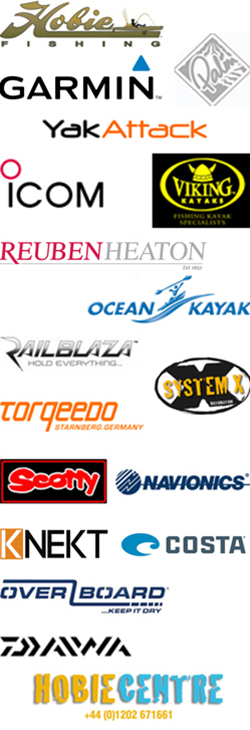Hobie Revolution 13
I’m not one for putting up reviews on kayaks after only a few trips. I’ve now lived with the Hobie Revolution 13 for 18 months so I should have by now have a good idea of how she performs. First the vital statistics.
Length: 13' 5" / 4.09 m
Width: 28.5" / .72 m
Capacity: 350 lbs / 159 kg
Fitted Hull Weight: 69.5 lbs / 31.52 kg
Fully Rigged Weight: 82.8 lbs / 37.56 kg
Hull Construction: Rotomolded Polyethylene
Why the Revolution 13. Firstly my choice was mainly down to length and weight. I like a 13ft or longer when fishing at sea, the Outback was a little shorter and to be honest I couldn’t get over the looks of her. Weight wise, I needed something that I could car top easily unaided, as most of the time I fish alone as most of my trips are a bit cut and dash, grabbing a weather window when family commitments allow. The Hobie Revolution 13 is also a handsome beast, very sleek lines, and she looks fast.
As soon as I got her home I started to look at fitting her out, I was use to having a centre consul, so with a Mirage drive taking up the central position and quite narrow gunnels there is really only a couple of options. RAM Balls fitted directly to the gunnels or accessory rails. I chose to go down the rail route, utilizing Yak Attacks excellent GTSL90 tracks and accessories which have been perfect for my needs, the unique adjustability for all my gear has been eye opening and I would recommend Yak Attack gear to anyone looking for flexibility on their kayak.
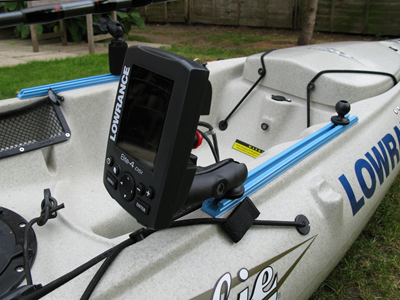
Yak Attack GTSL90 track system.
Anyway back to the Hobie Revolution review.
The Hobie Revolution 13 comes with standard Mirage Drive, which means the smaller fins. Although they are adequate and it doesn’t stop you using the kayak, I immediately upgraded to the ST Turbo fins, I had used the standard fins on an outback and I wasn’t happy with the lack of power.
The ST Turbo fins require a little more effort to get going, but once on the move a slow cadence will keep you travelling at a good rate of knots, faster than most paddlers with far less effort. A must have upgrade.

Hobie ST Turbo Fins.
The Mirage drive when dropped into the slot in the hull clips in place, this can be quite tricky at first, you need to have the fins held just right in the down position and the front of the Mirage Drive level with the bottom of the opening, then you just drop into place, two cams then lock the drive into position with a satisfying click.

Mirage Drive locked in place.
The arms on the Mirage Drive are adjustable depending on your leg length, squeezing the leg lifts a pin out of the main leg and you can then slide to the required position, release to lock the pin, the drive is clearly numbered so that you can get both the legs into the same position easily.
Its worth mention now that to remove the drive, you flick the Hull clips over and lift, with both Mirage Drive legs together (flippers down). I would suggest that it is worth fitting a leash to the Mirage Drive attached to the Hull, losing the Mirage Drive in the surf could be expensive.
The Hobie seat locks into the hull with two plastic pins, there are two positions in the hull so the seat can be placed forward or back, I prefer the back position. Once locked into position a couple of Velcro straps cover the pins. The rear of the seat has a self-inflating comfort pad. Unlike paddling, the seat back is best positioned reclining rather than upright; think recomberant cycle and you’ll get the idea. The seat is very well padded and I don’t have a problem being sat in it for up to 7 hours at a time without any numbing which is excellent for a standard kayak seat.

Hobies excellent seat.
OK, out on the water. You need to wade out to at least knee deep, a little deeper if your short like me before dropping in the Mirage drive, I’ll either paddle out to deep water first, or if the water is calm I’ll push off hard and drop into the seat, then pop the drive in.
As soon as you are afloat you also need to get the rudder down, hopefully remembering to release the bungee which holds it in place for transporting, if not, your going to have to paddle back to shore, or drop over the side to release, although you can just about do it with the paddle blade, yes I quite often forget to release the rudder!
To lower the rudder you need to pull on the right hand cockpit toggle, it has down on it to remind you, this looks off on a flat Jam Cleat below the webbed tackle pocket, you must lock it off otherwise it will start to rise out of the water as you peddle forward.
Rudder is controlled by a handle on the left of the cockpit, conveniently situated next to the seat. Worth noting, the rudder up toggle is on the left side of the cockpit. The toggle system works very well indeed, I have upgraded my rudder to a larger size, it’s actually off a Hobie Cat so its huge, but this makes for a very responsive craft and helps when utilizing the sail kit.
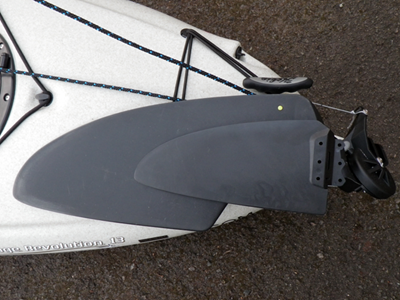
Standard Hobie Revolution rudder with on top of upgraded rudder.

Rudder under rudder keep.
So we are off, a quick fast burst of the pedals and then settle down to a slow cadence. A big mistake that most people make when trying out a Hobie is that they want to see how fast they are, they peddle like crazy and tire very quickly. All that effort is not required, like I say a quick burst 4 or 5 pumps and away.
If you have had to use the standard Hobie paddle to either get out to deeper water or reverse out of a sticky situation, (the Hobie can be peddled in reverse by turning the Mirage rive around in the slot), you can park it either side of the cockpit, there are two moulded rails to sit the paddle on then it locks in place with a bungee paddle keep clipped on top of the gunwale.
The Hobie Revolution 13 with its sharp bow cuts through waves as they steepen, and so in a heavy sea you are going to be in for a damp but exhilarating ride, the water is very quick to disperse from the cockpit through the Mirage Drive slot, however some water will sit in the seat well and stay there, there are a pair of scupper holes which have bungs in as standard, these can be unscrewed to allow water to drain if this becomes a problem, I find the seat height tends to keep me out of the wet stuff.
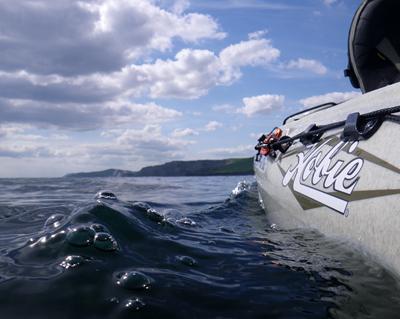
With water coming over the front, some does find its way into the hull, no more than on many of the kayaks I have paddled in the past, this appear to find its way in through the holes which are used to hinge the main hatch lid.
Hatches. There are three hatches on the Hobie Revolution 13. The huge main hatch in front of the cockpit, this allows access to the main hull and is large enough to stow a kayak trolley. There is an accessory which sits into this hatch which allows you to store stuff without it disappearing inside the hull, whether this attributes to some water getting inside the hull who knows, it’s a possibility as its adding another layer between the lid and hull without a double seal. The front hatch is held down with a double bungee which is held in position by a pair of raised plastic buttons at the front of the cockpit, the system is very easy to use, even at sea. A nimble kayak fisherman can gain access to the front hatch on the water if required, but not advised in any kind of swell.
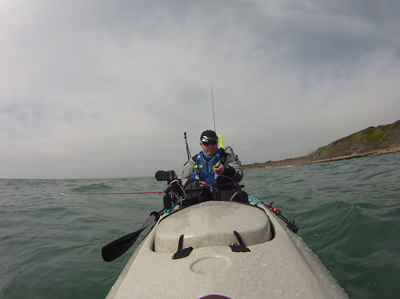
Front hatch showing bungee hinge.
There are a further two round hinged hatches onboard, both opened with a cam style twist lock, one in front of the seat in which there is a round tackle box and another hatch at the rear of the tankwell giving access to the rudder cables should there be an issue, inside the hatch lids there should be a long grey piece of plastic, don’t worry if its not there on your second hand kayak, but if new, make sure its there. This is a replacement pin for the rudder should it fail at sea.

Twist lock hatch with tackle box.
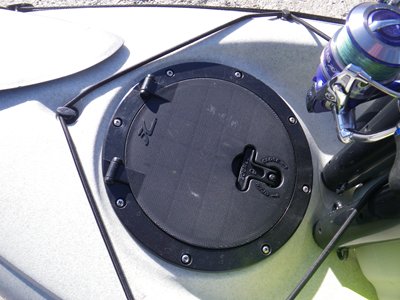
Tankwell twist lock hatch.
There is also the two webbed tackle storage area’s in the cockpit and a cup holder, useful for dropping end tackle into as you change gear. I keep pliers and snacks in the two webbed storage areas, although they are held shut with a plastic button, I suspect that gear will be lost from these should you tip out.
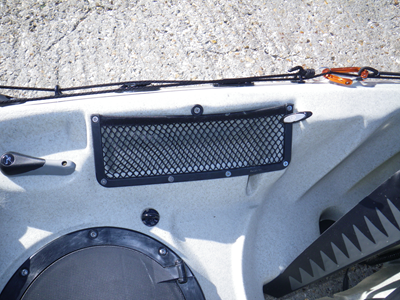
Webbing over storage area.
Cockpit storage is of a premium, and at times it can be a little frustrating not having somewhere to put everything. When bait fishing this can become a bigger issue for me, I tend to keep the bait box in front of the Mirage Drive.
The Tankwell is big, but very shallow, especially as you get towards the rear hatch, a bungee criss crosses over the area and is easily removed if required, two plastic hooks attach it behind the seat and it then loops over button toggles around the sides of the tankwell. The tankwell is big enough to take a standard crate.
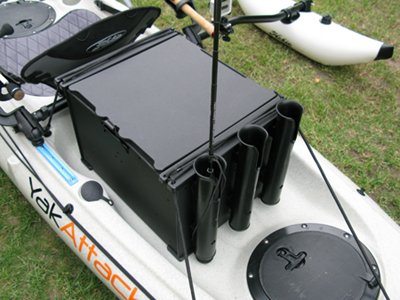
Yak Attack Black Pak in tankwell.
Either side of the tankwell are moulded in flush mounts for rods, these have rubber caps to keep water out, not that it can enter the hull through the flush mounts.
Carry handles. There are four handles, one front and rear toggle style handles, the rear one slightly off set so that it fits around the raised rudder. They are both comfortable when carrying the kayak. Either side of the cockpit are solid rubber coated handles, these make loading and unloading from the roof rack on the car very easy with no wrapped knuckles which happens with the web style handles found on many kayaks. The side handles are also centrally balanced allowing single-handed carrying from one handle.
Out on the water the Hobie Revolution 13 is generally well behaved and very easy to use. Drifting whilst fishing is easy with a quick adjustment of the rudder you can with a bit of practice stay on course easily. Changing lures or tackle as peddling is relatively easy, but I have found there is a requirement to keep checking the rudder as you can easily head off course.
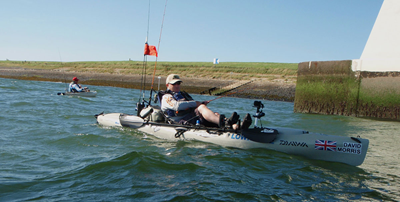
It's rougher than it looks.
Heading into wind couldn’t be easier, much easier than pushing a paddle through the wind, speed can be maintained very easily and she handles these conditions very well.
One of the beauties of having a Mirage Drive is when you want to fish a strong tide, you don’t need to anchor, you can sit facing into the tide and just peddle slowly, you’ll stay put, not something you can do with any paddle kayak, this is a reason why many of my kayak fishing buddies have a Hobie in their fleet of kayaks even when they are die hard paddlers, just so they can fish those impossible marks.
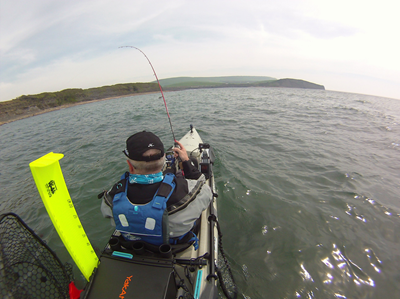
Drifting over a shallow reef.
I’ve only had a couple of scares at sea and these are generally when you would normally be putting in the odd brace when paddling in a wind over tide situation with awkward swell. The Revolution 13 has a habit of trying to broach, rolling on the swell and trying to turn, this could be down to the much larger rudder that I like to use, but with nothing to brace with it can be a little uncomfortable to say the least. Another strange feeling is when the fins leave the water in deep short spaced swell, not a major problem, but an odd feeling none-the-less a little like a slipping clutch.
As I mainly lure fish now, using an anchor is a rare thing indeed, but when I do have the need then the Revolution 13 sits well in the tide, you can use the peddles down to act as a keel which keeps you nice and straight in the tide and stops to much rolling.
Returning to the beach through surf, I tend to leave the fins in place but locked up against the hull, there is hooked bungee in the cockpit to lock the peddles in this position, surfing, she is very well behaved and so far I have no problems to report.
Looking after the Mirage Drive. The fins are expensive to replace so they need looking after, especially around rocks in shallow waters, it’s quite easy to put a hole in the leading edge at the tip of the blades. One way to combat this is to smear some Goop or silicone adhesive around the tips; this will take the knocks and can be easily peeled off and redone. The fins have an aluminium rod running through them, this can bend if you hit rocks or like me do a pirouette on a sunken rock, you’ll know if the rod is bent as the fins will look floppy on the trailing edge, they are very easy to straighten in a vice, but remove from the drive before hand.
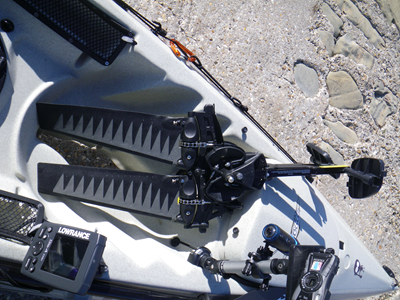
Look after the Mirage Drive and it will give you years of service.
After use, always wash down the Mirage Drive with fresh water and add a little WD40 or the like to the drive chains, moving parts and bare cables. Check the drive over whilst your at it, just in case.
Overall I have so far loved my time on the Hobie, it suits my style of fishing. I could at times do with a little more storage as can be found on the Outback, but otherwise I wouldn’t change her, she is considerably faster than the Outback and Revolution 11 especially with Turbo Fins fitted. All the Hobie fittings are top quality. I love the interchangeable accessory plugs around the hull, the quality of the moulding is very good indeed, the thickness of the polyethylene is excellent, although this adds to the hulls weight. She has internal foam added under the seat and rear tankwell to add buoyancy; she is a very well designed bit of kit. The only improvement I would have liked to see is the ability to fit a transducer externally in a protected manor, a transducer can be fitted externally but offers little protection. The Hobie Revolution has now been upgraded with the Lowrance Ready 2014 hulls which include a transducer slot with cover, this makes a great kayak near perfect.

Hobie Lowrance Ready transducer cover.
If you lure or fly fish I couldn’t recommend the Hobie Revolution 13 enough, if you bait fish you may be better off with an Outback, if you fish freshwater only then I’d bet tempted with a ProAngler 14, although you really need a trailer and easy access for that one, she is heavy to car top, but very nimble on the water.
